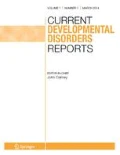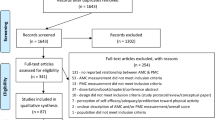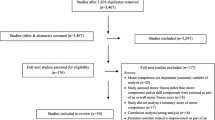Abstract
Purpose of Review
Strong links exist in children and adolescents with high motor competence between physical activity level, physical fitness and self-concept. Are similar associations also evident for those with developmental coordination disorder (DCD), and do they vary with age or between genders?
Recent Findings
Low levels of physical activity and fitness have been identified in those with DCD, but self-concept was not considered in these studies. The picture is muddied by the many terms used to investigate the self. We identified that self-concept is not necessarily lower in those with DCD if they do not believe physical prowess is important. However, gender- and age-related differences were identified.
Summary
For those with DCD, even though physical self-perceptions are low, their general self-concept is not necessarily diminished. By adolescence, broader sources of information are drawn upon to inform self-concept and unimportant influences disregarded. Future research should seek to understand these influences in order to better support the development of a healthy self-concept.

Similar content being viewed by others
References
Papers of particular interest, published recently, have been highlighted as: • Of importance •• Of major importance
• Jaakkolat T, Huhtiniemi M, Salin K, Seppala S, Lahti J, Hakomen H, et al. Motor competence, perceived physical competence, physical fitness and physical activity within Finnish children. Scand J Med Sci Sports. 2019;29(7):1013–21 This very recent study includes all aspects of our model.
Vedul-Kjlsas V, Sigmundsson H, Stensdotter A-K, Haga M. The relationship between motor competence, physical fitness and self-perception in children. Child Care Health Dev. 2011;38(3):394–402. https://doi.org/10.1111/j.1365-2214.2011.01275.x.
Hands B, Larkin D. Physical fitness and developmental coordination disorder. In: Cermak SA, Larkin D, editors. Developmental coordination disorder. San Diego: Thomson Learning; 2002. p. 172–84.
• Rivilis I, Hay J, Cairney J, Klentrou P, Liu J, Faught B. Physical activity and fitness in children with developmental coordination disorder: a systematic review. Res Dev Disabil. 2011;32(3):894–910. https://doi.org/10.1016/j.ridd.2011.01.017This paper summarises studies involving the DCD population.
•• Rose E, Parker H, Larkin D, Hands B. Does motor competence affect self-perceptions differently for adolescent males and females? SAGE Open Press. 2015; October–December: 1–9. https://doi.org/10.1177/2158244015615922. This paper considers how gender and motor competence impact on self-perceptions.
Skinner RA, Piek JP. Psychosocial implications of poor motor coordination in children and adolescents. Hum Mov Sci. 2001;1-2:73–94. https://doi.org/10.1016/S0167-9457(01)00029-X.
APA. Diagnostic and statistical manual of mental disorders: DSM-5. 5th ed. Washington (DC): American Psychiatric Association; 2013.
Purcell C, Scott-Roberts S, Kirby A. Implications of DSM-5 for recognising adults with developmental coordination disorder (DCD). Br J Occup Ther. 2015;78(5):295–302. https://doi.org/10.1177/0308022614565113.
Cantell MH, Smyth MM, Ahonen TP. Clumsiness in adolescence: educational, motor and social outcomes of motor delay detected at 5 years. APAQ. 1994;13:115–29.
Losse A, Henderson SE, Elliman D, Hall D, Knight E, Jongmans M. Clumsiness in children do they grow out of it? A 10-year follow-up study. Dev Med Child Neurol. 1991;33(1):55–68.
Kirby A, Williams N, Thomas M, Hill EL. Self-reported mood, general health, well-being and employment status in adults with suspected DCD. Res Dev Disabil. 2013;34:1357–64.
Tal-Saban M, Zarka S, Grotto I, Ornoy A, Parush S. The functional profile of young adults with suspected developmental coordination disorder (DCD). Res Dev Disabil. 2012;33:2193–202.
WHO. International Classiifcation of Functioning, Disability and Health (ICF). 2002. https://www.who.int/classifications/icf/icfbeginnersguide.pdf
Casperson CJ, Powell, Christenson GM. Physical activity, exercise , and physical fitness: definitions and distinctions for health-related research. Public Health Rep. 1985;100(2):126–31.
Rhodewalt F, Agustsdottir S. Effects of self-presentation on the phenomenal self. J Pers Soc Psychol. 1986;50(1):47–55.
• Marsh HW, Shavelson R. Self-concept: its multifaceted, hierarchical structure. Educ Psychol. 1986;20(3):107–23. https://doi.org/10.1207/s15326985ep2003_1This paper provides a comprehensive overview of self-concept as a construct.
Harter S. The construction of the self. Developmental and sociocultural foundations. (2nd ed). Guilford Press: NY; 2015.
•• Lindwall M, Asci FH, Palmeira A, Fox KR, Hagger MS. The importance of importance in the physical self: support for the theoretically appealing but empirically elusive model of James. J Pers. 2011;79(2):303–33. https://doi.org/10.1111/j.14676469.2101.00678.xAn excellent paper discussing the value placed on the physical self with an historical perepective.
Piaget J. Origins of intelligence in the child. London: Routledge & Kegan Paul; 1936.
•• Hattie J. Getting back on the correct pathway for self-concept researching the new millennium: revisiting misinterpretation and revitalizing the contributions of James’ agenda for research on the self. In: Craven RG, Marsh HW, editors. Self-concept Theory, Research and Practice: Advances from the New Millennium. Collected papers of the inaugural Self-concept Enhancement and Learning Facilitation (SELF) Research Centre International Conference, Sydney, Australia. 2000. p. 42–66. This paper identifies the missing links in research involving self-concept and suggests a new approach.
Jennings KD. Mastery motivation and the formation of self-concept from infancy through early childhood. In: Messer DJ, editor. Mastery motivation in early childhood: Development, measurement, and social processes. NY: Routlege; 1993. p. 36–54.
Stodden DF, Goodway JD, Langendorfer SJ, Roberton MA, Rudiseill ME, Garcia C, et al. A developmental perspective on the role of motor skill competence in physical activity: an emergent relationship. Quest. 2008;60:290–306.
Horn TS. Developmental perspectives on self-perceptions in children and adolescents. In: Weiss MR, editor. Developmental sport and exercise psychology: a lifespan perspective. Morgantown: Fitness Information Technology; 2004. p. 101–43.
LeGear M, Greyling L, Sloan E, Bell RI, Williams B-L, Naylor P-J, et al. A window of opportunity? Motor skills and perceptions of competence of children in Kindergarten. Int J Behav Nutr Phys Act. 2012;9(1):29. https://doi.org/10.1186/1479-5868-9-29.
Marsh HW, Ellis LA, Craven RG. How do preschool children feel about themselves? Unraveling measurement and multidimensional self-concept structure. Dev Psychol. 2002;38(3):376–93. https://doi.org/10.1037/0012-1649.38.3.376.
Festinger L. A theory of social comparison processes. Hum Relat. 1954;7:117–40.
Marsh HW, Craven RG. Swimming in the school: expanding the scope of the big fish little pond effect. In: Marsh HW, Craven RG, editors. Self-concept theory, research, and practice: advances for the new millennium [CD-ROM]. Sydney, New South Wales, Australia: University of Western Sydney; 2000. p. 75–91.
McIntyre F, Parker H, Chivers P, Hands B. Actual competence, rather than perceived competence, is a better predictor of physical activity in children aged 6-9 years. J Sports Sci. 2018;36(13):1433–40. https://doi.org/10.1080/026404.2017.1390243.
Smyth M, Anderson HI. Coping with clumsiness in the school playground: social and physical play in children with coordination impairments. Br J Develop Psych. 2000;1893): 389–413. https://doi.org/10.1348/026151000165760.
Bouffard M, Watkinson EJ, Thompson LP, Causgrove Dunn JL, Romanow SKE. A test of the activity deficit hypothesis with children with movement difficulties. Adapt Phys Act Q. 1996;13(1):61–73. https://doi.org/10.1123/apaq.13.1.61.
Cairney J, Hay J, Faught BE, Corna LM, Flouris AD. Developmental coordination disorder, age, and play: a test of the divergence in activity-deficit with age hypothesis. Adapt Phys Act Q. 2006;23(3):261–76. https://doi.org/10.1123/apaq.23.3.261.
Hands B. Changes in motor skill and fitness measures among children with high and low motor competence: a five-year longitudinal study. J Sci Med Sport. 2008;11:155–62.
Li Y-C, Wu SK, Cairney J, Hsieh C-Y. Motor coordination and health-related physical fitness of children with developmental coordination disorder: a three-year follow-up study. Res Dev Disabil. 2011;32:2993–3002.
Vedul-Kjelsas V, Stensdotter A, Haga M, Sigmundsson H. Physical fitness, self-perception and physical activity in children with different motor competence. Eur J Adapt Phys Activ. 2015;8(1):45–57.
Harter S. Self-perception profile for children: manual and questionnaires (grades 3–8). Denver: University of Denver; 2012.
Harter S. Self-perception profile for adolescents. Manual and questionnaires (14–19 years). Denver: University of Denver; 2012.
Rose E, Hands B, McIntyre F, Parker H. Does physical fitness and the importance placed on physical attributes influence perceived physical self-worth in adolescents with low motor competence? Adapt Phys Activ Q. (under review).
Fox KR. The physical self-perception profile manual. De Kalb IL: Northern Illinois University; 1990.
Hands B, Parker H, Rose E, Larkin D. Gender and motor competence affects perceived likelihood and importance of physical activity outcomes among 14 year olds. Child Care Health Dev. 2015;42(2):246–52. https://doi.org/10.1111/cch.12298.
Blomfield Neira CJ, Barber BL. Social networking site use: linked to adolescents’ social self-concept, self-esteem, and depressed mood. Aust J Psych. 2014;66:56–64. https://doi.org/10.1111/ajpy.12034.
Vandenbosch L, Eggermont S. The interrelated roles of mass media and social media in adolescents’ development of an objectified self-concept: a longitudinal study. Commun Res. 2015;43(8):1116–40. https://doi.org/10.1177/009365021560048.
Valkenburg PM, Schouten AP, Peter J. Adolescents’ identity experiments on the internet. New Media Soc. 2005;7:383–402. https://doi.org/10.1177/1461444805052282.
Brustad RJ. Attraction to physical activity in urban schoolchildren: parental socialization and gender influences. Res Q Exerc Sport. 1996;67(3):316–23.
•• Nobre G, Valentini N. Self-perception of competences: concept, changes in childhood, and gender and age-group differences. J Phys Educ. 2019;30:e3008. https://doi.org/10.4025/jphyseduc.v30i1.3008A recent article that addresses both gender and developmental differences in self-perceptions.
Timler A, McIntyre F, Bulsara C, Rose E, Hands B. Exploring the influence of motor competence on adolescent identity health: a mixed method study. Res Q Exerc Sport. 2019. https://doi.org/10.1080/02701367.2019.1643821.
Poulsen AA, Ziviani JM, Cuskelly M, Smith R. Boys with developmental coordination disorder: loneliness and team sports participation. Am J Occup Ther. 2007;61(4):451–62.
Timler A, McIntyre F, Hands B. Adolescents’ self-reported motor assessments may be more realistic than those of their parents. Br J Occup Ther. 2018;81(4):227–33. https://doi.org/10.1177/0308022617743681.
Sallis JF. Age-related decline in physical activity: a synthesis of human and animal studies. Med Sci Sports Exerc. 2000;32(9):1598–600.
Ridgers N, Fazey D, Fairclough S. Perceptions of athletic competence and fear of negative evaluation during physical education. Br J Educ Psychol. 2007;77(2):339–49.
Mantzicopoulos P. Younger children’s changing self-concepts: boys and girls from preschool through second grade. J Genet Psychol. 2006;167:289–308.
Hands B, Larkin D, Rose E. The psychometric properties of the McCarron Assessment of Neuromuscular Development with Australian youth: a longitudinal study. Hum Mov Sci. 2013;32:485–97. https://doi.org/10.1016/j.humov.2013.02.007.
O’Mara AJ, Green J, Marsh HW. Administering self-concept interventions in schools no training necessary? A meta-analysis. Int Educ J. 2006;7(4):524–33.
Hands B, Parker H. Physical education and activity in children and adolescents with DCD. In: Barnett A, Hill E, editors. Understanding motor behaviour in Developmental Coordination Disorder. Oxon: Routledge; 2019. p. 137–58.
•• Rose E, Larkin D. Perceived competence, discrepancy scores and global self-worth. Adapt Phys Act Q. 2002;19:127–40 This study identified differences in self-perceptions between DCD and typically developing children.
Cairney J, Bedard C, Dudley D, Kriellaars D. Towards a physical literacy framework to guide the design, implementation and evaluation of early childhood movement-based interventions targeting cognitive development. Ann Sport Med Res. 2016;3(4):1073-1-1073-5.
• Harter S. Effectance motivation reconsidered. Toward a developmental model. Hum Dev. 1978;21:34–64. https://doi.org/10.1159/000271574This paper presents a developmental approach to self-concept.
Author information
Authors and Affiliations
Corresponding author
Ethics declarations
Conflict of Interest
The authors declare that they have no conflict of interest.
Human and Animal Rights and Informed Consent
This article does not contain any studies with human or animal subjects performed by any of the authors.
Additional information
Publisher’s Note
Springer Nature remains neutral with regard to jurisdictional claims in published maps and institutional affiliations.
This article is part of the Topical Collection on Motor Disorders
Rights and permissions
About this article
Cite this article
Hands, B., Rose, E., Chivers, P. et al. The Relationships Between Motor Competence, Physical Activity, Fitness and Self-Concept in Children and Adolescents with DCD. Curr Dev Disord Rep 7, 35–42 (2020). https://doi.org/10.1007/s40474-020-00189-8
Published:
Issue Date:
DOI: https://doi.org/10.1007/s40474-020-00189-8




